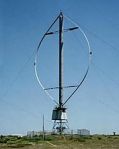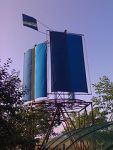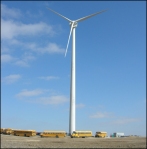Filed under: Rebecca Sargent, Sustainability | Tags: alternative energy, housing, sustainable housing, wind energy, wind power, wind turbine
It costs anywhere between $2,000-$8,000/per kilowatt power produced to purchase a small wind turbine. However, the wind turbine costs represent only 12%-48% of the total cost of a small wind electric system. There are also costs for other components, such as inverters and batteries, as well as sales tax, installation charges and labour. People sometimes opt to install the turbine themselves.
After installation, there are maintenance costs, as with any mechanical device. These are said to average approximately 1% of the original cost per year. The blades and bearings need to be replaced approximately every ten years. The wind turbine can last 20-30 years (or longer) if properly installed and maintained. It must be oiled, greased and safety inspected regularly. Bolts and electrical connections must be checked annually, along with checking for corosion and to ensure proper tension on the guy wires.
In cold conditions the turbine will have to de-iced and the batteries must be stored in an insulated place. Turbines should never be placed on a rooftop, as they are said to cause damage to the roof through vibrations. There have also been some complaints of noise or vibrations causing discomfort to those living inside a home with a turbine on the roof.
The turbine does produce noise. From a distance of 250 m away a typical wind turbine produces approximately 45 dB (A) decibels) of noise. This is similar to the noise inside a typical office building. If not properly installed or maintained, turbines have the potential to get louder.
The blades of most turbines are made of fibreglass or wood, and as such are transparent to electromagnetic waves such as radio and tv.
They must be placed in a large open area with a certain level of wind (which varies depending on the type and size of the turbine). It is recommended to have them in an open area free of trees or buildings, approximately 1/2 an acre or more in size for best use.
From what I have read, the claim that wind turbines are dangerous to birds is misleading, with a large window on a home posing more of a threat. This can be reduced with certain measures, such as netting.
Wind power does not create toxic by-products in its generation. Some of the material inside the batteries can be toxic, and should be disposed of properly. Overall, the environmental impact and toxicity of turbines is considerably less than the use of fossil-based or nuclear energy. The electrical components should be stored properly to keep away children or animals, like any other mechanical or electronic devices capable of carrying electricity.
There are a couple types of wind turbines, the horizontal axis wind turbine (HAWT) and the vertical axis wind turbine (VAWT), a design more like an egg-beater.
- Horizontal Wind Turbine
- Vertical Wind turbine
- Wind Turbine
- Wind Turbine
An adequate wind turbine can generate 50-100%+ of a household energy needs. If it creates a surplus of energy, this energy can usually be sold to a local energy provider. How much do you pay for energy every year? If your energy bill was $0 every year, how much would you save? How long would these savings take to pay for the system? Probably much less than 20 years, the lifespan of a typical wind turbine.
A wind turbine is not for every property or person, and is best used in combination with other energy systems (such as passive heating and cooling, geothermal systems and solar devices). But if you live in a rural environment and have space available, it is an option you should consider. There are government grants available to help subsidize the costs, and savings in the long term will help pay for the system.
The more we move towards alternative renewable energies, the more options there will be and the cheaper they will become.
Filed under: Rebecca Sargent, Sustainability | Tags: green real estate, housing, real estate, renewable energy, sustainable housing, sustainable living
Most of our energy comes from non-renewable resources such as coal, oil, natural gas or radioactive elements. Once removed from the ground and used, these energy sources can take up to millions of years to reform. At the rate we are going, most of the resource deposits in the earth will be completely used up in less than 200 years (and maybe faster).
Renewable energy replaces itself quickly and can come from the natural flow of sunlight, wind or water. We need to spend more time and energy developing ways to harness these natural energies and to do so using sustainable resources. There are actually relatively cheap and easy ways to build yourself energy collecting devices You can check out www.re-energy.ca for some ideas to get you started. They can also be installed or retrofitted into your home so that you can create as much energy as you use and be more sustainable. This can result in great energy and money savings!
Did you know that Natural Resources Canada, the Canadian Mortgage and Housing Corporation and National Research Council Canada have been working together to export innovations in energy efficient housing (http://www.super-e.com/)?
We do have the research abilities here in Canada. In fact, we even have a Canadian Centre for Housing Technology to help test it out for us (http://www.ccht-cctr.gc.ca/). Many of these energy-efficient houses look just like any other suburban or city area from the outside. They have been working on these projects for over a decade, why are they not yet reaching the market?
Consumer choice and lifestyle will have a huge impact on the housing market and it’s progression. Look into other energy options. You might find out that an intitial investment will actually save you in the long run. You might even be able to help fund it through governments grants and incentives.
If you want more details, please ask me.






